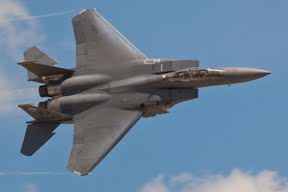Just a year and a half after leaving his job as a copier salesman, James Murphy found himself climbing behind the controls of one of the U.S. Air Force’s most expensive fighter jets, a $16 million F-15.
“When I was lowering myself down in that seat, I wondered how in the world did I transform — how did I get here so quickly — and I started looking around my jet at the maintenance loaders, the weapons loaders, the fuelers,” Murphy said. “I’m thinking, here’s a group of extremely young, diverse people that have come from all different parts of the country, different walks of life [and] we’re all executing at a very high level.”
His transformation from “farm boy to fighter pilot,” as he called it, was brought about by the military’s process of developing high-performing teams. Murphy, now founder and CEO of Afterburner Inc., a training company, said those lessons he learned as a fighter pilot can be transferred to business. The key is a process that elite military teams like fighter pilots and Navy SEALs use to continually improve and hone their performance: the mission debrief.
William Duke, a U.S. Navy veteran who has logged more than 1,800 hours piloting a Nimitz-class nuclear-powered aircraft carrier, said a simple practice like debriefing allows people, whether they are special operations team members or business people, to respond quickly to changes in the environment.
“We live in a world that is so fast, we don’t have time to suffer analysis paralysis,” said Duke, director of learning and development at Afterburner and co-author with Murphy of The Debrief Imperative: The Secret Tool That Is Transforming Businesses the World Over. “You’ve got to be faster than the rate of change to be effective in the marketplace.”
Deconstructing Debriefing
One of the most important things a team can do when a mission or project is over is go into a room and debrief in what Murphy called a “nameless, rankless environment.” They look at the plan they laid out before the mission, execution against that plan and then closely analyze the results to identify gaps, whether they were errors or successes, that can be translated into lessons learned.
“That step-by-step lesson learned is something that can completely change the enterprise in the way they look at that mission the next time it might occur or it changes how that individual team will plan or brief their next mission so they can execute it at a higher level,” Murphy said.
There are a number of key elements to successful debriefing. Murphy and Duke sum them up using the acronym STEALTH, which translates to:
• Set the time: include debriefing into the plan for any project or mission.
• Tone: make sure the debriefing feedback is nameless and rankless.
• Execution vs. objectives: review what happened and determine results.
• Analyze execution: find out the root causes of those results.
• Lesson learned: findings should be clear and precise.
• Transfer: transmit and store that lesson.
• High note: end a debrief session with a positive summary.
Transparent communication is key to a successful debrief, and it’s also one of the biggest shortfalls in execution. In business, team activities are often tied to a bonus or outcome that affects a person’s take-home pay or status in the organization. That focus stifles open communication.
“To truly understand, not just the results on paper, but the inherent things that led up to those results which are human-factor driven, that communication factor is critical — it’s got to be truly open or we’re never really going to get down to a root-cause analysis,” Murphy said.
To effectively use debriefing, CLOs should teach leaders to set the tone by doing what Murphy called “inside-outside” criticism first. The leader first criticizes his or her own role in the mission and then asks the team what they think he or she could have done better on that project.
“Two to three daggers is all you have to take as a leader,” Murphy said. “This isn’t let’s kill the boss, this is one, two maybe three at the most, great feedback items that will make you a better leader, but it starts the trust process.”
Applying the Lessons Learned
Over time, the team will come to understand they are free to admit errors or successes as part of a safe haven created by debriefing. Reprimands have no place, provided the operation was carried out within established standards. The only thing that leaves the debrief is the lesson learned.
“If you’re cascading lessons learned from the field level all the way up through the C-suite of management, you can make adjustments,” Murphy said. “Regardless of the size of your organization, if your teams or your organization as a whole have a discipline of debriefing, lessons learned are going to be passed up the chain of command and across the silos of the business.”
That open communication and adjustment on the fly will help companies stay ahead of the competitive rate of change in their environment every day, as opposed to waiting for an annual or quarterly review to make adjustments, Murphy said.
“When you start debriefing and you realize that everyone can learn from everyone else and it’s not about what you did right or what you did wrong, it’s about what we as a team can do better, that becomes infectious and it changes those very difficult hierarchical cultures into more collaborative teams,” Duke said.
Execution against objectives is critically important right now, Murphy said. When the economy was booming, many organizations didn’t find it necessary to operate at a high level to be successful. Good times painted over many of the errors and weaknesses.
“But now the opportunities to close and sell and to increase your business requires a rigor that is much higher because the economy is not near as helpful,” Murphy said. “Companies can’t afford to not debrief because they have to stay ahead of the curve and they have to evaluate what’s going on.”
Mike Prokopeak is editorial director of Chief Learning Officer magazine. He can be reached at mikep@CLOMedia.com.












